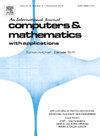Numerical simulation of pollutant concentration patterns of a two-dimensional congestion traffic
IF 2.9
2区 数学
Q1 MATHEMATICS, APPLIED
引用次数: 0
Abstract
An accurate calculation of the traffic density is a key factor in understanding the formation and evolution of the traffic-related emission concentration in urban areas. We have developed a two-dimensional numerical model to solve traffic flow/pollution coupled problem whose pollution source is generated by the density of vehicles. The numerical solution of this problem is calculated via an algorithm that combines the Characteristic method for temporal discretization with the Lagrange-Galerkin finite element method for spatial discretization. This algorithm is validated by varying certain physical parameters of the model (effective viscosity). We study the pollutant concentration diffusion impacted by the presence of an obstacle in a bifurcation topology traffic. We draw attention to the influence of the wind velocity as well as its direction on the pollutant concentration diffusion, in several situations. The temporal evolution of pollutant concentration at various relevant locations in the domain (before and after an obstacle) is studied for a single velocity and two wind directions. Different regimes have been observed for transport pollution depending on time and the wind direction.
求助全文
约1分钟内获得全文
求助全文
来源期刊

Computers & Mathematics with Applications
工程技术-计算机:跨学科应用
CiteScore
5.10
自引率
10.30%
发文量
396
审稿时长
9.9 weeks
期刊介绍:
Computers & Mathematics with Applications provides a medium of exchange for those engaged in fields contributing to building successful simulations for science and engineering using Partial Differential Equations (PDEs).
 求助内容:
求助内容: 应助结果提醒方式:
应助结果提醒方式:


